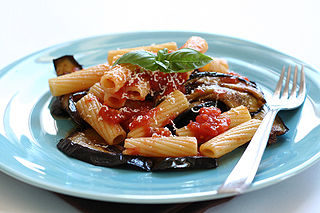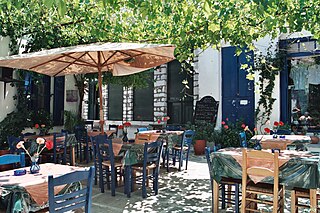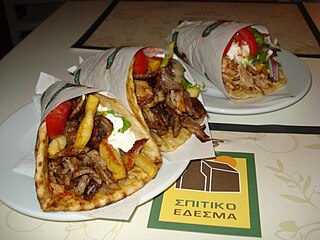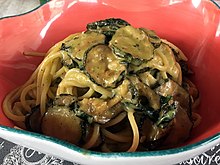
Spaghetti is a long, thin, solid, cylindrical pasta. It is a staple food of traditional Italian cuisine. Like other pasta, spaghetti is made of milled wheat, water, and sometimes enriched with vitamins and minerals. Italian spaghetti is typically made from durum-wheat semolina. Usually the pasta is white because refined flour is used, but whole wheat flour may be added. Spaghettoni is a thicker form of spaghetti, while spaghettini is a thinner form. Capellini is a very thin spaghetti, while vermicelli refers to intermediate widths, varying between the United States and Italy.

Sicilian cuisine is the style of cooking on the island of Sicily. It shows traces of all cultures that have existed on the island of Sicily over the last two millennia. Although its cuisine has much in common with Italian cuisine, Sicilian food also has Greek, Spanish, French, Jewish, and Arab influences.

Carbonara is a pasta dish made with eggs, hard cheese, fatty cured pork, and black pepper. It is typical of the Lazio region of Italy. The dish took its modern form and name in the middle of the 20th century.

Fettuccine Alfredo is a pasta dish made with fettuccine, butter, and Parmesan cheese. As the cheese is mixed with freshly cooked, warm fettuccine and ample butter, it melts and emulsifies to form a smooth, rich cheese sauce coating the noodles. Originated in Rome in the early 20th-century, it is now popular in the United States and other countries. Cream is commonly added to American versions, which are often served as a main course with optional chicken, shrimp, salmon or other ingredients on top or on the side.

Spaghetti alla puttanesca is a pasta dish invented in Naples in the mid-20th century and made typically with tomatoes, olive oil, olives, anchovies, chili peppers, capers and garlic, with vermicelli or spaghetti.

A taverna is a small Greek restaurant that serves Greek cuisine. The taverna is an integral part of Greek culture and has become familiar to people from other countries who visit Greece, as well as through the establishment of tavernes in countries such as the United States and Australia by expatriate Greeks.

Italian-American cuisine is a style of Italian cuisine adapted throughout the United States. Italian-American food has been shaped throughout history by various waves of immigrants and their descendants, called Italian Americans.

Spaghetti and meatballs is an Italian-American pasta dish consisting of spaghetti, tomato sauce and meatballs.

Neapolitan cuisine has ancient historical roots that date back to the Greco-Roman period, which was enriched over the centuries by the influence of the different cultures that controlled Naples and its kingdoms, such as that of Aragon and France.

In Japanese cuisine, yōshoku refers to a style of Western-influenced cooking which originated during the Meiji Restoration. These are primarily Japanized forms of European dishes, often featuring Western names, and usually written in katakana. It is an example of fusion cuisine.

Spaghetti aglio e olio is a pasta dish typical of the Italian city of Naples. It is a typical dish of Neapolitan cuisine and is widely popular. Its popularity can be attributed to it being simple to prepare and the fact that it makes use of inexpensive, readily available ingredients that have long shelf lives in a pantry.

Roman cuisine comes from the Italian city of Rome. It features fresh, seasonal and simply-prepared ingredients from the Roman Campagna. These include peas, globe artichokes and fava beans, shellfish, milk-fed lamb and goat, and cheeses such as pecorino romano and ricotta. Olive oil is used mostly to dress raw vegetables, while strutto and fat from prosciutto are preferred for frying. The most popular sweets in Rome are small individual pastries called pasticcini, gelato and handmade chocolates and candies. Special dishes are often reserved for different days of the week; for example, gnocchi is eaten on Thursdays, baccalà on Fridays, and trippa on Saturdays.

Bolognese sauce, known in Italian as ragù alla bolognese or ragù bolognese, is a meat-based sauce in Italian cuisine, typical of the city of Bologna. It is customarily used to dress tagliatelle al ragù and to prepare lasagne alla bolognese.

Pasta alla Norma, earlier called pasta con le melanzane, is an Italian dish of pasta and eggplant. It is typical of Sicilian cuisine, from Catania in particular.

Greek-American cuisine is the cuisine of Greek Americans and their descendants, who have modified Greek cuisine under the influence of American culture and immigration patterns of Greeks to the United States. As immigrants from various Greek areas settled in different regions of the United States and became "Greek Americans," they carried with them different traditions of foods and recipes that were particularly identified with their regional origins in Greece and yet infused with the characteristics of their new home locale in America. Many of these foods and recipes developed into new favorites for town peoples and then later for Americans nationwide. Greek-American cuisine is especially prominent in areas of concentrated Greek communities, such as Astoria, Queens and Tarpon Springs, Florida.

The traditional cuisine of Abruzzo is eclectic, drawing on pastoral, mountain, and coastal cuisine. Staples of Abruzzo cuisine include bread, pasta, meat, fish, cheese, and wine. The isolation which has characterized the region for centuries has ensured the independence of its culinary tradition from those of nearby regions. Local cuisine was widely appreciated in a 2013 survey among foreign tourists.

Pasta alla gricia is a pasta dish originating in the Lazio region of Italy.















